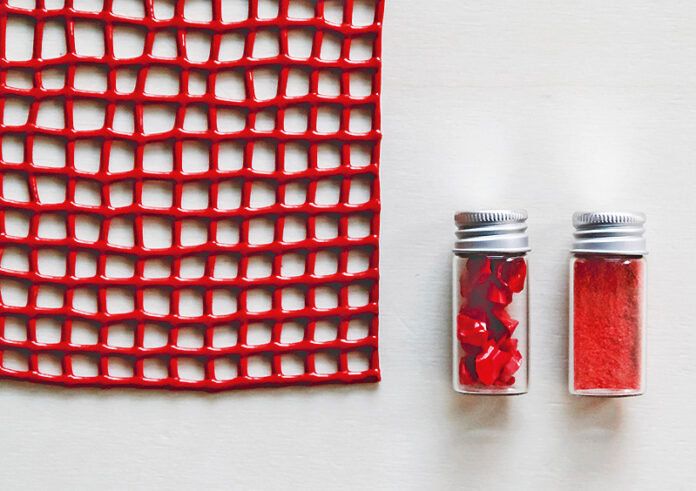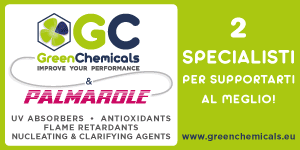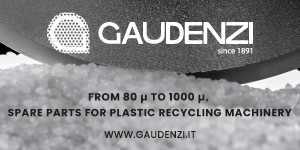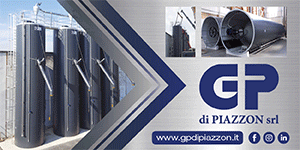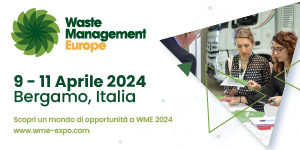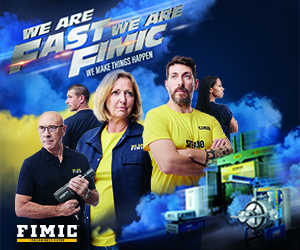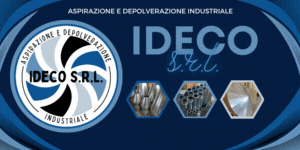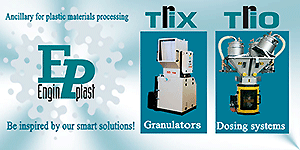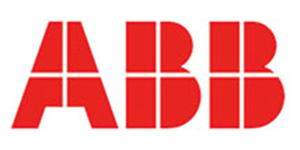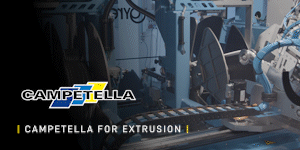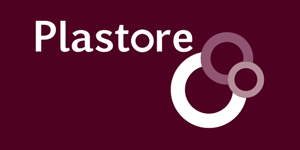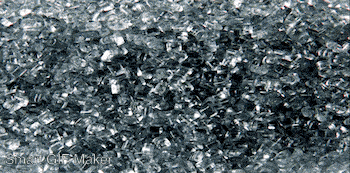rehub, starting from the problem of production waste in Murano’s artistic glassworks, has devised a new glass processing method
The Murano glassworks are world-famous for their artistic creations that reflect an ancient tradition of fine craftsmanship. But few know that, precisely because of their uniqueness, 50 per cent of the glass handled on the island becomes waste. This translates into tonnes of waste glass that cannot be recovered in the recycling chain and is therefore destined for landfill as special waste.
Solving problems of this magnitude requires ingenious ideas such as the one devised by Matteo Silverio, founder of rehub, an innovative start-up that has invented a new method of glass processing.
“I have a degree in architecture, but my passion is working in the field of glass between research, art and design,’ says Silverio. Seven years ago, almost by chance, after several important experiences also abroad, I returned to Venice with my wife, Marta Donà, originally from Murano, and together we decided to start a course on new technologies to bring innovation to an enchanted world rooted in tradition like that of the world’s most famous artistic glassworks. We involved six glassworks and associated them with six designers with the intention of starting new experiments.
At the beginning it was not easy to combine technique and creativity, then the master glassmakers started to interact when they realised that the idea was not to replace their products and processes but to create a synergy with the aim of implementing innovative projects. With the support of the Ca’ Foscari University of Venice and the Consorzio Promovetro Murano, we were able to set up an exhibition in the former headquarters of the Venice Chamber of Commerce. My current work was born from that extemporaneous experience. I am now a lecturer on the Master in Digital Architecture at the Iuav University of Venice and a design and research consultant to help understand the impact of new technologies on the activities of Murano’s artistic glassworks.
There are indeed high value-added processes that have to be carried out by hand and that are the discriminating factor between craftsmanship and industry. But there are other low value-added activities that can be modified in order to reduce the environmental impact of energy-intensive processing, which produces a huge amount of waste and also represents a considerable expense for glassworks.
In Murano today, half of the processed art glass, about 1000 tonnes per year, cannot be recycled because of the pigments added to colour it, such as copper, cobalt, manganese, iron and gold, which cannot be mixed with the glass packaging that is regularly recycled within the national circuit (CoReVe).
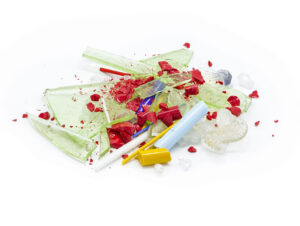 We started with a local issue, but non-recyclability is a characteristic that Murano glass shares with other types of glass: the normal glasses we use in the home, lamps and light bulbs, but also the double-glazing of windows are in fact made of glass that must be thrown in the undifferentiated garbage or delivered to the ecological islands. Glass is a bit like plastic: there are many types with different characteristics.
We started with a local issue, but non-recyclability is a characteristic that Murano glass shares with other types of glass: the normal glasses we use in the home, lamps and light bulbs, but also the double-glazing of windows are in fact made of glass that must be thrown in the undifferentiated garbage or delivered to the ecological islands. Glass is a bit like plastic: there are many types with different characteristics.
And even if glass is made up of more or less the same ingredients, it has different coefficients that make it incompatible with each other and in melts lead to serious problems, because the materials expand in different ways, creating micro-stresses that turn into micro-fractures and then into real fractures. Many glassworks recycle their waste to create small objects such as paperweights, picture frames, etc., but these are isolated experiences that only marginally affect the overall problem. Glass is basically sand (silica), but its processing requires a great deal of energy, which forces companies to make economies of scale, i.e. to produce a lot with bigger and bigger furnaces”.
A revolutionary idea comes to life
“We ‘millennials’ were born with an awareness of the importance of sustainability, and so, as a native ecologist, I decided to participate in a research call on the circular economy issued by the University of Venice, and I won it, developing a process aimed at producing objects to demonstrate its applicability not only in a critical and problematic context for Venice, but also repeatable in other areas.
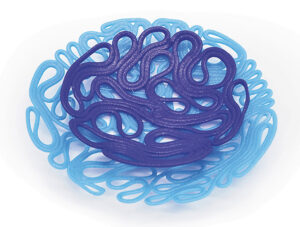 In 2020, for the first time, I devised a process that can transform waste glass into a kind of soft paste that can be moulded by hand, through additive processes, by our patent-pending extruder 3D printers or by using rolling or injection moulding techniques.
In 2020, for the first time, I devised a process that can transform waste glass into a kind of soft paste that can be moulded by hand, through additive processes, by our patent-pending extruder 3D printers or by using rolling or injection moulding techniques.
3D printing of glass is not new, but it exists as a hot process and is energy-intensive.
We have devised a cold process, which saves a lot of energy and recovers a valuable material, which glassworks willingly supply to us, saving disposal charges and promoting the circular economy.
In 2022, together with my wife Marta, I set up rehub Srl, whose name already embodies and promotes the process described: the prefix ‘re’ summarises the four Rs of the circular economy (reduce, reuse, recycle, recover); ‘hub’ is the junction, the place of transformation. But the phonetic pronunciation refers to ‘rehub’: our mission is to give new life to non-recyclable glass waste through creative technologies and processes intended to influence modern design”.
rehub has won many awards: first place in Starthub 2022, a competition organised by the Iuav University of Venice to identify the most promising entrepreneurial ideas of students and ex-students; second place in the StartCup Veneto, which awarded the 5 best start-ups in the region; second out of 60 start-ups at Mit DesignX Venice, an acceleration programme of the prestigious MIT in Boston.
At the National Innovation Award, rehub was the only startup from Veneto among the winners, winning the selection to participate in the Polimi Encubator acceleration path and two awards: the Green&Blue Climate Change Award, and the ‘WMF We Make Future – Festival on Digital Innovation’ Award held in Rimini in June 2023.
At the Venice Innovation Design in July, rehub was honoured by Domitilla Dardi, winning participation and EDIT Napoli 2023, an international design festival, in which it received a special mention in the competition as the best new entry.
Currently, rehub is a finalist in the upcoming awarding of the Marzotto Venture Accelerator prize by RePower.
The near future
The innovative process of rehub develops a potential for customisation that manifests itself in shapes, geometries and patterns, even of considerable size, that are impossible to realise with traditional glassmaking techniques.
“Creating objects with new applications and endless possibilities, combining modern technology with human know-how in craftsmanship, research, design and art, is our ultimate aim. We do not want to replace artistic and industrial glassworks in any way because we do different things; we are possibly complementary and our focus remains recycling not production per se,’ Silverio specifies.
Now we are trying to figure out how to improve the paste to make it more plastic and we aim to make the process more versatile.
In the meantime, over the past year we have enjoyed the collaboration of Erica Villa, science popularizer and head of communications and marketing at rehub, who unfortunately had to leave us recently.
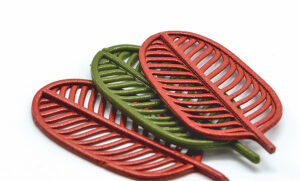 We are trying to figure out how to structure the team to grow it in a harmonious and consistent way without losing sight of what is really important. I have won many awards but currently the entrepreneurial risk is all on my shoulders. Both Erica and I are young but we are also parents and we want to approach each step in a mature way, which means being aware of our strengths but also of our limits. Erica has been responsible for conveying our idea and the process by promoting collaborative projects. We are surrounding ourselves with people who can help us understand which is the best way to grow and increase the volumes that can potentially be processed. The machines we currently have are very good prototypes with a high degree of efficiency, but they need to become industrial machines that allow companies producing glass waste to be able to reprocess it.
We are trying to figure out how to structure the team to grow it in a harmonious and consistent way without losing sight of what is really important. I have won many awards but currently the entrepreneurial risk is all on my shoulders. Both Erica and I are young but we are also parents and we want to approach each step in a mature way, which means being aware of our strengths but also of our limits. Erica has been responsible for conveying our idea and the process by promoting collaborative projects. We are surrounding ourselves with people who can help us understand which is the best way to grow and increase the volumes that can potentially be processed. The machines we currently have are very good prototypes with a high degree of efficiency, but they need to become industrial machines that allow companies producing glass waste to be able to reprocess it.
We would like to export these two innovations, the transformation of glass into paste and the creation of machines suitable for shaping it, as widely as possible, in order to give young people an example of a more sustainable and technological way of doing business, and our children a better Planet than the one we inherited.” Matteo Silverio concludes.
Photos by Michele Mescolin



